duties were to "announce all the visitors and ... to take care of all the paper work." (Vilips dep. 61) 1Voitkus, however, ascribed a more important role to Hazners: "He was one of the leading officers there [at Annas Street]." (Voitkus dep. 52) Parups stated that Hazners passed on orders from his superiors and received reports, (tr. 11963)
In summary, the respondent's witnesses do not agree on what Hazners did at Annas Street or how much time he spent there. Hazners offered their testimony to provide himself with an alibi for the three months of September, October and November, 1941, but the contradictions in their accounts undermine their testimony to the point that it should be given no weight by this court.
V
ISSUES OF FACT
The factual issues have been highlighted in the foregoing discussion of the government's case and the respondent's defense. To recapitulate, they are as follows:
(1) Three government witnesses put Hazners at the Prefecture in early July and mid-July. Hazners claimed to have been outside Riga at the beginning of July, and at the Self-Defense Headquarters in the middle of the month.
(2) Two government witnesses saw Hazners at the gate of the Riga ghetto in the fall of 1941; the respondent said he was at the Annas Street Headquarters during that period, doing nothing but paper work.
A. THE PREFECTURE
2Ber Mendelkorn was taken to the Prefecture "in the first days of the month of July," 1941. (tr. 684) Mendel Wulfowitz was brought there "in the first days, when the Germans entered Riga." (tr. 2795)
Examination
1“Voitkus, however, ascribed a more important role to Hazners: 'He was one of the leading officers there [at Annas Street].' (Voitkus dep. 56) Parups stated that Hazners passed on orders from his superiors and received reports, (tr. 11967)”
Voitkus' and Parups' accounts most closely track to Hāzners's memoir. That there are inevitable contradictions is understandable when testimony of Hāzners's duties does not come from someone directly in his command structure. The INS could have cleared up the question of Hāzners's duties if only it referenced the records in its possession. Instead, it contended that the uncertainty of some witnesses constituted contradiction of others who were more certain, and painted expected inconsistencies as indicating deceit.
Nazi probe's shadow reaches Capitaland
Washington Co. resident linked to Latvian crimes
TIMES UNION, ALBANY, SUNDAY, NOVEMBER 28, 1976
...
Dr. Schneider, who lost many members of her family at the hands of the Nazis, is not prepared to be sympathetic.
“It is an outrage that can only make our young people cynical about how easy it is to get away with mass murder,” she said. “Why should we ever prosecute someone who is a mugger or someone who just commits one murder when these people have shown us, have shown the world, how cheap they viewed human life to be?”
Gertrude Schneider brought the fabricated Soviet charges against Hāzners back from the USSR, having danced with the KGB operative who passed them off to her, and who mentioned Hāzners to her by name. Even so, even with U.S. authorities entering Soviet propaganda into evidence, the judge disallowed consideration of the concerted Soviet campaign to discredit Hāzners.
What is far more questionable than inconsistencies in the responses of defense witnesses is that the witnesses the INS found were all recent Soviet émigrés, all found in the same manner, all prepared for trial by the same Israeli investigator. All after German investigators had cleared Hāzners. Nowhere is this more troublesome than with the government's leading and star witness, Ber Mendelkorn, who testified:
- Hāzners beat him so hard (at the Prefecture) his teeth fell out later; and
- Hāzners herded Jews into a synagogue and burned them.
- Hāzners was a major, four diamonds on his collar, when he brutalized Mendelkorn.
Testimony so gripping that scholar Gertrude Schneider added Hāzners to the names of accused Latvian collaborators burning the Gogol Street synagogue.8
Our first instinct would be to attribute Mendelkorn's testimony to mistaken identity. (The in-courtroom identification was a farce because Hāzners attended every day of every hearing and sat next to his attorney the entire time.) However, in examining evidence introduced from witnesses, we found a Latvian-language Soviet propaganda treasure trove prominently featuring Hāzners, including photographs, in the Mendelkorn exhibits:
- "Vini Bez Maskas"—They, Unmasked
- "Kas Ir Daugavas Vanagi"—Daugavas Vanagi, Who Are They
- "Politiskie Begli Bez Maskas"—Political Fugitives Unmasked
- "Mes Apsudzam"—We Accuse
 Hāzners's portrait in a 1984 Soviet propaganda publication, There Shall Be Retribution. Note the four diamonds, a rank Hāzners was promoted to only near the end of the war, also the rank he was accused of having in 1941 in witness testimony.
Hāzners's portrait in a 1984 Soviet propaganda publication, There Shall Be Retribution. Note the four diamonds, a rank Hāzners was promoted to only near the end of the war, also the rank he was accused of having in 1941 in witness testimony.As far as we are aware, all bear the same picture of Hāzners as we reproduced in his biography. At right is the same picture in the English-language "There Shall Be Retribution." Clearly, Mendelkorn recalls Hāzners's rank from propaganda, not from personal experience. If someone is close enough to beat you so hard your teeth later fall out, as the fight or flight response is searing every moment of the event into your mind, this is not the sort of thing you can possibly get wrong in your testimony.
Indeed, Mendelkorn was quite emphatic regarding Hāzners's rank. Therefore, there are only two possibilities, that Mendelkorn was mistaken regarding Hāzners's identity (nearly all the witnesses honed in on one particular photograph of Hāzners) or he was spinning a tale to put away someone whom publications in Latvia and the Israeli investigator had assured him was a war criminal guilty of killing hundreds. In either case, Hāzners was innocent.
If there were any doubt as to the fabrication of charges against Hāzners or that the Soviets were determined to discredit him, twenty years after first naming Hāzners in Daugavas Vanagi, Who are They?, and well after Hāzners's vindication, the Soviet ambassador to the United Nations accused Hāzners9 by name as a war criminal who herded Jews into a burning synagogue, no longer in Rīga—given the failure of those bogus charges—but now in Belarus.
| 1 | Testimony of Peter Vilips, 6-April-1978, deposition. |
| 2 | Testimony of Verness Voitkus, 2-November-1978, deposition. |
| 3 | Testimony of Eriks Parups, 10-April-1978, direct, transcript pp. 1192–1206. |
| 4 | Testimony of Ber Mendelkorn, 25-October-1977, direct, transcript pp. 15–93. |
| 5 | Testimony of Mendel Wulfowitz, 27-October-1977, cross examination, transcript pp. 254–316. |
| 6 | Testimony of Verness Voitkus, 2-November-1978, deposition. |
| 7 | Testimony of Eriks Parups, 10-April-1978, direct, transcript pp. 1192–1206. |
| 8 | That is, Schneider does not accuse Hāzners in her original thesis, but adds him as a perpetrator in her Journey published in 2001. |
| 9 | "Khazners," an artefact of double-transliteration. |
